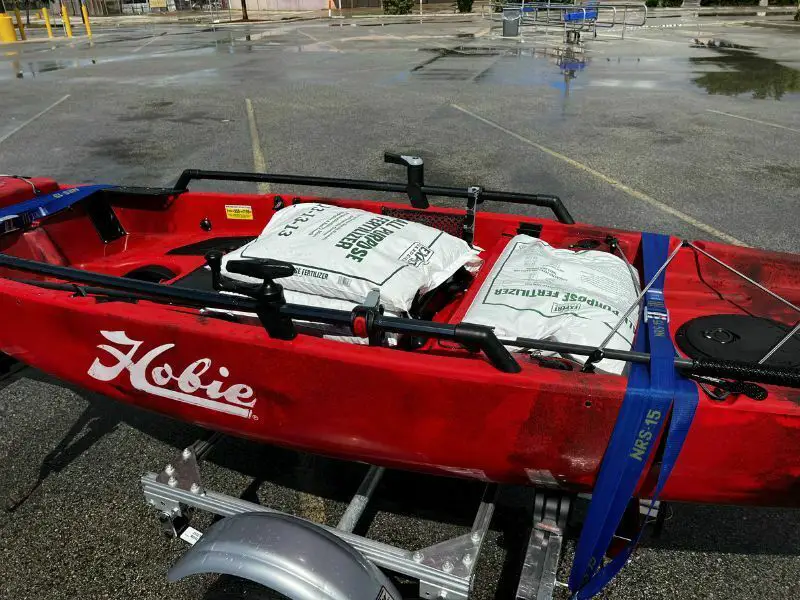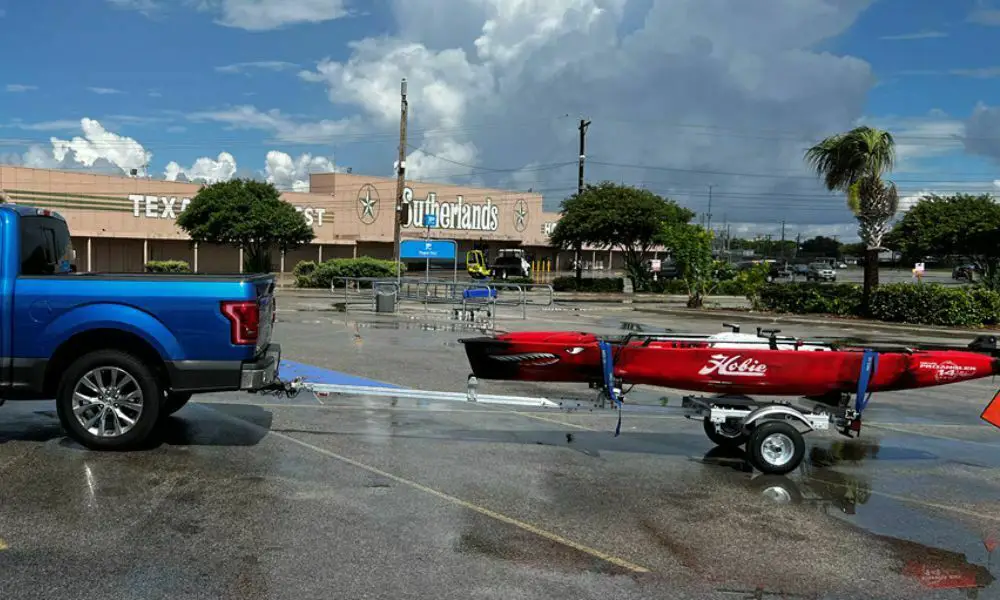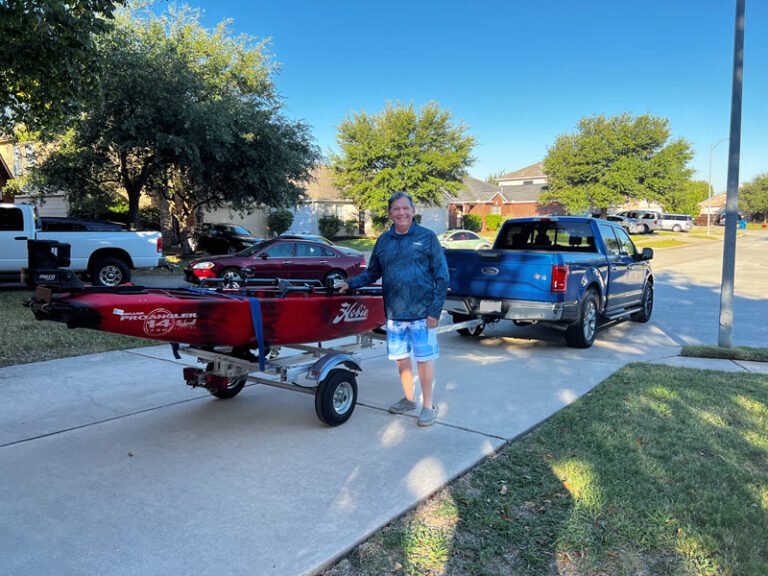Kayak Trailer Bouncing: How To Stop Hopping While Traveling On The Road
Recently, I bought a new kayak and trailer from a shop in Corpus Christi. However, while driving around town, I noticed that the trailer bounced excessively. To avoid damaging my purchase or, worse—getting into an accident—I had to find a way to stabilize it quickly.
Struggling with a kayak trailer that hops and bounces on the road? This article will teach you how to stop it quickly and easily.
In this article, I will review some tactics that finally solved my issue with my kayak trailer bounce. By the end of this article, you will know how to eliminate this problem entirely.
What Are Kayak Trailer Hops, And How Do They Occur?
If you’re a kayak fisherman who stores your kayak on a trailer, you’ve probably experienced the phenomenon known as “trailer hops.” This is when your trailer and the kayak on top jump up off the road continuously up and down and sometimes from side to side.
This can happen when the trailer hits potholes, dips in the street, bumps, or slight rises due to changes in the pavement on the highway and grooves in sections of a road. While trailer hops may not seem like a big deal, they can cause severe damage to your kayak and/or your trailer.
The Dangers Of Kayak Trailer Bouncing And What Can Happen As A Result
If your trailer jostles too much from consistent bumps in the road, it can cause extensive damage to your kayak and/or trailer. This is because many small vibrations over time weaken the hull structure until it cracks or breaks.
Not only that, but the trailer itself takes a beating. The repeated vibrations and bounces tear down suspension springs and bushings and damage wheels and hubs.
Related Articles
Hobie Pro Angler 14: Top 10 Reasons It Is My First Fishing Kayak
Can A 14-Foot Kayak And Trailer Fit In My Garage?
The Best Way I Found To Prevent Your Kayak Trailer From Bouncing While Driving On The Road
I decided to stow some fertilizer bags in the kayak on top of the trailer to add weight and keep everything steady while driving. To provide optimum suspension, I placed the bags in the middle of the kayak directly above the axle.
I used 3 bags, each with 40 pounds of fertilizer. The fertilizer, which came in soft bags and was widely distributed, was the perfect addition without damaging the cockpit or hull.

This did wonders for preventing the kayak from bouncing around on the trailer. Even on windy days or bumpy roads, my kayak stayed nice and steady thanks to the extra weight.
These bags were only meant to be inside the kayak during transport. Not while stored in my garage or outside. This would prevent hull warping issues.
I experimented with the weight of the kayak trailer to get a smoother ride. I started with 160 pounds (4 bags), reduced it to 120 pounds (3 bags), and then 80 pounds (2 bags). 120 pounds (3 bags) was ideal for my needs.
Finding The Long-Term Solution
So, I started looking for something else that would be easier to use and less messy.
All you need is a set of heavy-duty sandbags. Sandbags are an ideal solution for this problem because they’re made of a thicker, more durable material that won’t leak or puncture easily. Plus, they have a carrying handle so you can easily move them around. Most importantly, they’ll help keep your trailer from bouncing around on the road.
To prevent your trailer from bouncing:
- Locate a spot on the trailer near the axle where you can place sandbags.
- After putting the sandbags in place, secure them so they don’t move around.
- Finally, ensure that weight is evenly distributed by making sure the sandbags are placed equally across the trailer’s surface area.
Alternative Ways To Keep Your Trailer From Bouncing
Adjusting The Tension In The Springs
Some have recommended changing the trailer’s suspension by loosening springs to reduce bumps’ impact on the road. Others suggest removing them altogether.
However, my Trailex SUT-220 model is rated for carrying up to 2,000 pounds and my Hobie Pro Angler 14 weighs only 350 pounds. And this model is designed with a tuned suspension especially constructed for proper trailering with a light load.
Before making any changes to my trailer’s suspension, I consulted the company recommendations. They suggested that changing the springs could reduce bumps’ impact on the road but doing so might void my warranty–which wasn’t worth it to me.
Lower The Trailer Tire Pressure
Another way to keep your trailer from bouncing is to lower the tire pressure. Although it may seem counterproductive, reducing the air pressure in your tires will give them a larger surface area to grip the road, which will help to keep your trailer stable.
However, keep the air pressure at the lower PSI recommendation, as it will create more resistance, reduce fuel efficiency, and cause tire damage over time. I chose not to do this because of the risks.
Properly Tie Down And Secure The Kayak To Your Trailer
You can also use kayak trailer tie-downs to secure your kayaks in place. I use NRS 1″ heavy-duty tie-down strap using a webbing strap, cam buckle tie-downs with s-hooks, or ratchet straps to ensure that your kayaks stay firmly in place. They also help to prevent movement when you are on the road.
Finally, if you have a kayak trailer with fenders and crossbars, make sure they are securely attached to the kayaks. A properly secured kayak trailer will provide additional stability and reduce bouncing. Additionally, make sure all kayaks are secure before heading out on the road. This will help to reduce kayak movement inside the trailer and, in turn, keep your kayak trailer from bouncing.
This practice does not solve my problem because I already take measures to ensure that my kayak is secure.
Distribute the Weight Evenly
One of the main reasons trailers bounce is because the weight is distributed unevenly. This is usually because there’s more weight on one side than the other. To fix this, move some heavier items from one side of the trailer to the other until the weight is evenly distributed. This will help keep your trailer more stable and minimize bouncing.
This is better advice for a general utility trailer than a single kayak trailer. The kayak needs to be centered with the hull weight over the axle so that it’s supported evenly by the springs. There are only options for improving bounciness with this alternative except by providing more cushioning support underneath where the kayak will sit on top of the trailer’s material.
Drive At A Slower Speed And Avoid Roads In Poor Condition
Trailers bounce for many reasons, but one is because they’re being driven too fast. When you hit a bumpy road, it’s best to slow down and take it easy. This will help keep your trailer from bouncing as much and make for a smoother ride overall.
I try to practice this every trip, although sometimes it takes effort to avoid deep potholes, divots, and grooves in the roads–especially along highways by the coast.
Conclusion
If you’re tired of your trailer bouncing around on the road, consider using sandbags to keep it in place.
Sandbags are made of a thick, durable material that won’t leak or puncture easily. Plus, they have a carrying handle, so you can quickly move them around. Most importantly, they’ll help keep your trailer from bouncing on the road.
So next time you hit the open road, bring along a set of sandbags!
Comment below and let me know your experiences!




